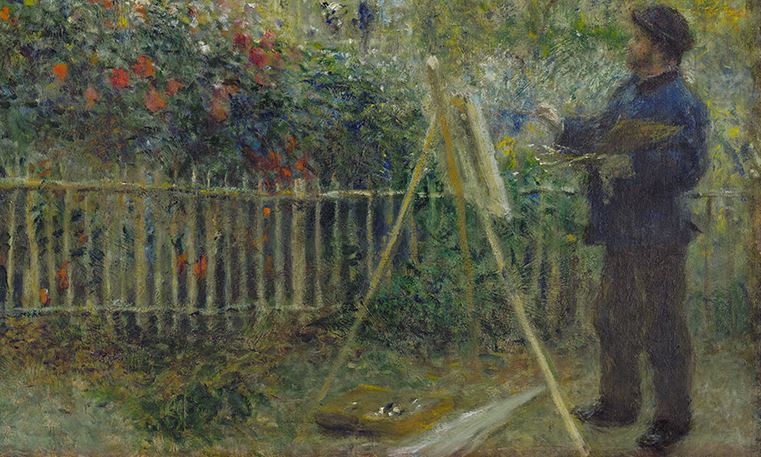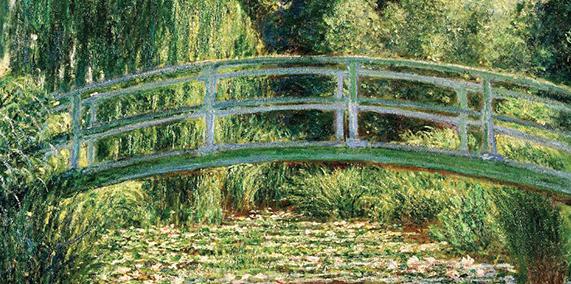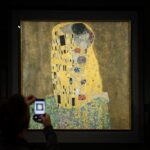Joyce Glasser reviews Painting the Modern Garden – Monet to Matisse (April 12 and from April 18th)
This comprehensive and well-directed documentary is part of Producer Phil Grabsky’s series of films complementing international art exhibits. Painting the Modern Garden, the blockbuster exhibit at London’s Royal Academy, is on until 20 April 2016 and is a must-see for artists, art lovers, gardeners, horticulturalists, and historians.
For those looking for some unusual tourists destinations, the film takes us on a trip to a few of the 19th and 20th century artists’ gardens – for example, the Die Brücke member Emil Nolde’s garden in Seebüll and, of course, Monet’s garden in Giverny – which are open to the public.
While Director David Bickerstaff is intent on showing us as many of the paintings in the exhibit as possible nothing can compare with the experience of entering the RA’s gorgeous rooms. That said, the film offers many extras to enhance our understanding of the context of the paintings, including some particularly perceptive and fascinating commentary from a variety of experts. 
Artist Lachlan Goudie laments our tendency to compartmentalise artists, reminding us that Monet was not only a painter, but a sculptor. ‘Monet was clearly a great sculptor because in his garden he is sculpting nature. He’s making sure there are larger flowers and small flowers; darker tones and lighter tones…’
Tim Marlow, the Artistic Director of the RA, also reminds us that there has never been a major exhibit looking at the role of the garden in modern art. ‘The ‘garden has been a very under rated site in the development of the evolution of modern art.’
Art historian Tim Richardson continues that thought. ‘The linkage of art and gardens is interesting and timely, partly because of the low cultural status of gardens in the hierarchy of the arts, which is somewhere down with knitting and embroidery…But many of the artists in this exhibit were interested, if not obsessed by their gardens. First of all, as a subject matter for their own work, but in some cases (most notably with Monet), the garden becomes an artwork in its own right.’
 The film begins with breathtaking footage from Monet’s garden in Giverny (as it is today), voiced over with a diary entry of the art dealer René Gimpel, being taken around the garden by Monet. But that’s a flash forward because the exhibit begins in 1873 long before Monet could afford to move to Giverny.
The film begins with breathtaking footage from Monet’s garden in Giverny (as it is today), voiced over with a diary entry of the art dealer René Gimpel, being taken around the garden by Monet. But that’s a flash forward because the exhibit begins in 1873 long before Monet could afford to move to Giverny.
One of many astute curatorial efforts, the RA obtained, and displays side by side, an 1873 painting by Monet of the dahlias in his garden of his rented accommodation in Argenteuil; and a painting by Renoir of Monet painting that very garden. Renoir does not show what Monet is painting (he leaves that to our imagination) but, in the words of Dr Clare AP Willsdon of the University of Glasgow, ‘it is as though Monet were taking the colours from the garden and transferring them with his brush to the canvas.’
The exhibit is not just Monet and the Impressionists (Pissarro, Caillebotte, Bazille, Van Gogh) – important though these artists are. We are also introduced to several lesser known international artists whose contributions are, in many cases, equally impressive.
You might know John Singer Sargent and Alfred Parsons, but you’ll want to book a trip to Madrid to experience the dreamy pink and green enclosed garden designed by painter Joaquin Sorolla. Near-by, we are treated to Sorolla’s enormous portrait of stained glass designer Louis Comfort Tiffany, painting in his opulent garden on Long Island Sound. The painting is so bright and colourful, sun glasses are recommended.
 Tom Coward, the Head Gardener of William Robinson’s garden at Gravetye Manor (Sussex) talks to us about the influence of Robinson’s books, notably The English Flower Garden and The Wild Garden in changing the static, formal Victorian gardens into gardens that allowed plants to express themselves in a natural way. Gertrude Jekyll is represented only by a painting of a pair of her boots, but her contribution was equally great. (There is only one painting by a woman artist in the show).
Tom Coward, the Head Gardener of William Robinson’s garden at Gravetye Manor (Sussex) talks to us about the influence of Robinson’s books, notably The English Flower Garden and The Wild Garden in changing the static, formal Victorian gardens into gardens that allowed plants to express themselves in a natural way. Gertrude Jekyll is represented only by a painting of a pair of her boots, but her contribution was equally great. (There is only one painting by a woman artist in the show).
The film explains the social and cultural evolution of the private garden, tracing it as a pictorial subject from the Garden of Eden in the Middle Ages, to the baroque era when gardens were associated with a king’s power. The rise of the middle class and numerous horticultural and scientific advances in the 19th century, for example, new hybrid flowers, containers to transport plants overseas and greenhouses facilitated the creation of the private garden.
Europeans believed in the restorative powers of the garden and therefore, as a place to spend time with their family. The German painter Max Liebermann (1847-1935), a founder of the Berlin Secession movement and Germany’s most famous painter (until Hitler) studied the latest garden design ideas and even wrote about them. He created an enormous and varied garden at his 1910 villa on the shore of Lake Wannsee that was tragically confiscated by the Nazi’s in the late 1930s. On the basis of his formal pencil design, photos and his paintings, the garden has been restored and opened to the public.
Gardens also served as outdoor studios allowing the artist to note the changes of light and weather on the plants. When this was not practical for Matisse, however, he often brought the garden into his studio. Referring to Monet, Ann Dumas, Curator at the Royal Academy, points out that, ‘he created his garden as an artist: he saw the blocks of colour that he was planting like pigments in a palette.’
 By 1883, Monet had a large family and enough money to rent a house in Giverny, upper Normandy. In 1890 he borrowed money from his art dealer to purchase it. The film relates the difficulty he had obtaining planning permission for his lilly pond as the local farmers protested that his exotic plants would poison their cattle. In the exhibit we are treated to some of the actual correspondence.
By 1883, Monet had a large family and enough money to rent a house in Giverny, upper Normandy. In 1890 he borrowed money from his art dealer to purchase it. The film relates the difficulty he had obtaining planning permission for his lilly pond as the local farmers protested that his exotic plants would poison their cattle. In the exhibit we are treated to some of the actual correspondence.
Monet once said, ‘Aside from painting and gardening, I’m good for nothing.’ After seeing the final two rooms of the exhibit, devoted to Monet’s water lilies, you’ll see just how good that was. He considered it his patriotic duty to remain in Giverny during WWI and was still painting, half blind, in 1926, at the time of his death,
Dr William Robinson of the Cleveland Museum of Art, explains that the impetus for the exhibit was the chance to reunite for the first time since 1926, a triptych of water lilies that was in Monet’s studio until his descendents sold them – sadly, to three separate museums in the USA, including Cleveland. Feast your eyes! Referring to the enormous, almost abstract triptych, painter Lachlan Goudie concludes that by this point, ‘it’s just about reflections: patterns of light and colour. He didn’t need a bridge any more or a tree trunk. All he needed were ripples and cascades of light.’




